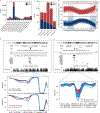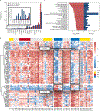Longitudinal personal DNA methylome dynamics in a human with a chronic condition
- PMID: 30397358
- PMCID: PMC8084418
- DOI: 10.1038/s41591-018-0237-x
Longitudinal personal DNA methylome dynamics in a human with a chronic condition
Abstract
Epigenomics regulates gene expression and is as important as genomics in precision personal health, as it is heavily influenced by environment and lifestyle. We profiled whole-genome DNA methylation and the corresponding transcriptome of peripheral blood mononuclear cells collected from a human volunteer over a period of 36 months, generating 28 methylome and 57 transcriptome datasets. We found that DNA methylomic changes are associated with infrequent glucose level alteration, whereas the transcriptome underwent dynamic changes during events such as viral infections. Most DNA meta-methylome changes occurred 80-90 days before clinically detectable glucose elevation. Analysis of the deep personal methylome dataset revealed an unprecedented number of allelic differentially methylated regions that remain stable longitudinally and are preferentially associated with allele-specific gene regulation. Our results revealed that changes in different types of 'omics' data associate with different physiological aspects of this individual: DNA methylation with chronic conditions and transcriptome with acute events.
Conflict of interest statement
Competing interests
The authors declare no competing interests.
Figures






Comment in
-
Personalized DNA methylomics.Nat Rev Genet. 2019 Jan;20(1):4-5. doi: 10.1038/s41576-018-0076-0. Nat Rev Genet. 2019. PMID: 30443004 No abstract available.
References
-
- Hood L & Friend SH Predictive, personalized, preventive, participatory (P4) cancer medicine. Nat. Rev. Clin. Oncol 8, 184–187 (2011). - PubMed
Publication types
MeSH terms
Substances
Grants and funding
LinkOut - more resources
Full Text Sources
Other Literature Sources
Molecular Biology Databases

